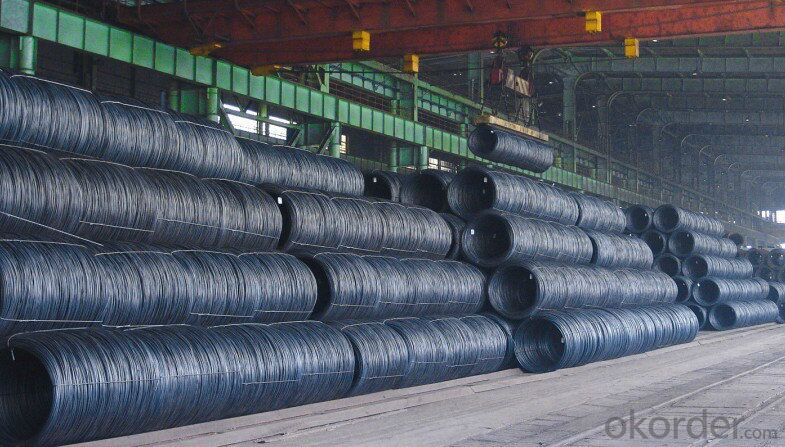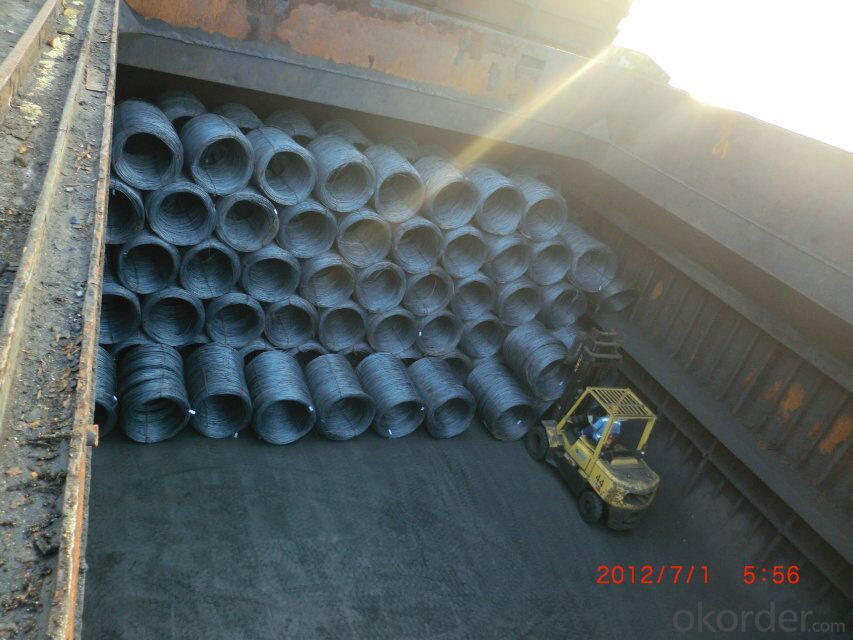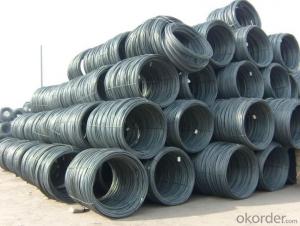high quality SAE1006 / SAE1008B Low Carbon Steel Wired Rod
- Loading Port:
- Tianjin
- Payment Terms:
- TT OR LC
- Min Order Qty:
- 25 m.t.
- Supply Capability:
- 5000 m.t./month
OKorder Service Pledge
OKorder Financial Service
You Might Also Like
Item specifice
Specifications of Steel Wire Rod in Coil:
Steel Grade: Q195/235, SAE1006-1018B Standard: ASTM, GB
Diameter: 5.5mm, 6.5mm, 7mm,8mm,9mm,10mm,12mm,14mm
Type: Drawn Wire Alloy or Not: Alloy Brand Name: HSKY
Technique: Hot Rolled Place of Origin: China Mainland
Chemical Composition:(Please kindly find our chemistry of our material based on SAE1006B and SAE1008B as below for your information)
High carbon/Low carbon/common carbon Steel wire rod | With boron for rebate tax |
Grade | SAE1006B SAE1008B SAE1018B |
Package | In coil ,in bundle, |
Coil weight | about 2000kg-3000kgs |
Size: | 5.5mm 6.5mm 8mm 10mm 12mm 14mm 16mm |
Types | High Carbon ,Low carbon ,Common carbon |
Exported Country | South Korea,Vietnam,Indonesia,Myanmar,Philippines and Afrca,Ect |
Delivery term: | within 30 days after receive the LC |
Payment Term: | LC at sight ,LC 30-120 days after B/L date, TT payment |
The Standard of Physical Properties:
Grade | Chemical Composition(%) | |||||
C | Mn | Si | S | P | Cr | |
SAE1006 | 0.03~O.07 | ≤0.32 | ≤0.30 | ≤0.045 | ≤0.040 | >0.30 |
Mechanical properties | ||||||
Yield strength(N/mm2) | Tensile strength(N/mm2) | Elongation(%) | ||||
250-280 | 350-380 | ≥32 | ||||
Grade | Chemical Composition(%) | |||||
C | Mn | Si | S | P | Cr | |
SAE1008 | 0.10max | 0.3~O.50 | 0.15max | 0.050max | 0.040 max | 0.30 min |
Mechanical properties | ||||||
Yield strength(N/mm2) | Tensile strength(N/mm2) | Elongation(%) | ||||
≥195 | 315-430 | ≥30 | ||||
Usage and Applications of Steel Wire Rod in Coil:
After hot-rolled the products shaped into coil and delivery as finished product, including round, square, rectangular, hexagonal and so on, Since most of the products are round, it is generally called wire rod. Steel wire rod is widely used in construction and manufacturing. Steel wire rod is mainly used for reinforcement of reinforced concrete and welded structure or reprocessed (roberts, nail etc) materials, especially used to produce wire drawing, welding electrode, nails,spring, electronic, precise machinery parts and so on.
Packaging & Delivery of Steel Wire Rod in Coil:
Packaging Detail: products are packed in coil and then shipped by container or bulk vessel
Each coil weight: 2-3MT
Delivery Detail: within 45 days after received deposit or LC.
Label: to be specified by customer, generally, each bundle has 1-2 labels
Trade terms: CFR, CIF


- Q:How is the straightness of steel wire rod measured?
- The straightness of steel wire rod is typically measured using a method called the straightness deviation test. This involves placing the rod on a flat surface and measuring the maximum distance between the rod and the surface at various points along its length. To perform the test, a straightedge or a precision straightness measuring instrument is placed on the surface parallel to the steel wire rod. Several measurements are taken along the length of the rod, typically at regular intervals. The distance between the rod and the straightedge is measured at each point, and the maximum deviation is recorded as the straightness deviation. The straightness deviation is usually expressed in terms of the maximum distance in millimeters or inches that the rod deviates from a perfectly straight line. A smaller deviation indicates a straighter rod, while a larger deviation indicates a more bent or curved rod. In addition to the straightness deviation test, other methods such as visual inspection or laser technology can also be used to assess the straightness of steel wire rod. These methods provide a more detailed and accurate measurement of the rod's straightness, allowing manufacturers to ensure that the rod meets the required quality standards for its intended application.
- Q:How does the corrosion resistance of steel wire rod vary with different coatings?
- The corrosion resistance of steel wire rod can vary significantly with different coatings. Coatings provide a protective barrier between the steel wire rod and its surrounding environment, preventing or slowing down the corrosion process. One commonly used coating for steel wire rod is zinc. Zinc coatings, such as hot-dip galvanizing or electro-galvanizing, create a layer of zinc on the surface of the steel wire rod. This zinc layer acts as a sacrificial anode, meaning it corrodes before the steel. As a result, the steel wire rod is protected from corrosion for a longer period. Zinc coatings are particularly effective in preventing rust and corrosion in outdoor or marine environments. Another popular coating for steel wire rod is epoxy. Epoxy coatings create a barrier between the steel wire rod and moisture or other corrosive substances in the environment. These coatings are often used in applications where the steel wire rod will be exposed to chemicals or harsh conditions that could accelerate corrosion. Epoxy coatings provide excellent resistance against chemicals, abrasion, and impact, making them suitable for various industrial and marine applications. Other coatings, such as polyethylene or polypropylene, can also be applied to steel wire rod to enhance corrosion resistance. These coatings are typically used in applications where the wire rod will be exposed to extreme temperatures or corrosive substances, such as in oil and gas pipelines. The polyethylene or polypropylene coatings act as a barrier, preventing moisture and chemicals from coming into contact with the steel wire rod, thereby reducing the risk of corrosion. In summary, the corrosion resistance of steel wire rod can vary depending on the type of coating applied. Zinc coatings provide sacrificial protection, epoxy coatings create a barrier against moisture and chemicals, and other coatings like polyethylene or polypropylene offer resistance to extreme conditions. The choice of coating depends on the specific application and the level of corrosion resistance required.
- Q:How is steel wire rod used in the production of wire mesh conveyor belts?
- Steel wire rod is a crucial component in the production of wire mesh conveyor belts as it serves as the primary material for manufacturing the wire mesh. The wire rod is drawn through a series of dies to reduce its diameter and increase its length, resulting in a long and thin wire. This wire is then woven or welded together to create the mesh pattern of the conveyor belt, providing strength, durability, and flexibility for conveying various materials.
- Q:How is steel wire rod used in the production of wire for mattress springs?
- Steel wire rod is a crucial component in the production of wire for mattress springs. It serves as the primary raw material that is used to create the strong and durable wire required for mattress springs. To begin the manufacturing process, steel wire rod is first carefully selected based on its desired properties, such as its tensile strength, flexibility, and resistance to corrosion. The rod is then subjected to a series of processes to transform it into wire suitable for mattress springs. The first step involves heating the steel wire rod and passing it through a series of dies to progressively reduce its diameter. This process, known as wire drawing, helps refine the wire's mechanical properties and ensures uniformity in its thickness. Once the wire has been drawn to the desired diameter, it undergoes further treatment to enhance its strength and resilience. This may involve heat treatment processes like annealing or quenching, which help to improve the wire's flexibility and resistance to fatigue. After the wire has been treated, it is coiled onto spools or reels, ready to be used in the manufacturing of mattress springs. The wire is then fed into specialized spring-making machinery, where it is formed into the required shape and size. These machines use a combination of bending, coiling, and twisting movements to create the intricate spring designs commonly found in mattresses. The high-quality steel wire rod used in the production of wire for mattress springs ensures that the springs are strong, durable, and capable of withstanding the constant pressure and weight applied to them. This results in a mattress that offers excellent support and comfort to the sleeper. In summary, steel wire rod plays a critical role in the production of wire for mattress springs. It undergoes various processes to refine its properties and is then shaped into the required form to create sturdy and resilient springs. This ensures that mattresses made with these springs offer superior support and durability to users.
- Q:What are the common methods used to protect steel wire rod from corrosion?
- There are several common methods used to protect steel wire rods from corrosion. These methods include: 1. Galvanization: Galvanization is a process in which a layer of zinc is applied to the surface of the steel wire rod. This layer acts as a sacrificial anode, meaning it will corrode instead of the steel when exposed to moisture or other corrosive elements. 2. Coating: Coating the steel wire rod with a protective layer is another effective method to prevent corrosion. Various types of coatings can be used, such as epoxy, polyethylene, or polyurethane. These coatings create a barrier between the steel and the surrounding environment, preventing moisture or corrosive substances from coming into direct contact with the metal. 3. Cathodic Protection: Cathodic protection is a technique that involves applying a direct electrical current to the steel wire rod. This current creates a protective electrochemical reaction, preventing the steel from corroding. This method is commonly used in environments where the steel is exposed to highly corrosive conditions, such as in marine or underground applications. 4. Proper Handling and Storage: Ensuring that steel wire rods are handled and stored correctly is crucial in preventing corrosion. This includes keeping the rods in a dry and well-ventilated area, away from moisture or corrosive substances. Additionally, using proper lifting and transportation methods can prevent damage to the rods' protective coatings or galvanized layer, which could lead to corrosion. 5. Regular Inspection and Maintenance: Regularly inspecting the steel wire rods for signs of corrosion and performing necessary maintenance can help prevent further deterioration. This may include removing any rust or damaged coatings, applying touch-up coatings, or re-galvanizing the rods if necessary. It is important to note that the choice of corrosion protection method will depend on various factors, such as the specific application, environmental conditions, and budget constraints. Consulting with corrosion experts or engineers can help determine the most suitable method for protecting steel wire rods from corrosion.
- Q:What are the main factors affecting the cost of steel wire rod?
- The main factors affecting the cost of steel wire rod include the price of raw materials, such as iron ore and scrap metal, as well as the cost of energy used in the manufacturing process. Other significant factors include market demand and supply dynamics, transportation costs, and any applicable trade tariffs or taxes. Additionally, fluctuations in currency exchange rates and global economic conditions can also impact the overall cost of steel wire rod.
- Q:How is steel wire rod stored and handled to prevent corrosion?
- Steel wire rod is stored and handled in a way that prevents corrosion by implementing various protective measures. Firstly, it is stored in a dry, well-ventilated area to minimize exposure to moisture. Additionally, the wire rod is often coated with a rust-resistant material, such as zinc or a special anti-corrosion coating, to provide an extra layer of protection. Furthermore, proper handling techniques are employed to prevent any damage to the protective coating, ensuring that the wire rod remains safeguarded against corrosion.
- Q:What are the different types of steel wire rod drawing dies?
- There are several different types of steel wire rod drawing dies, each designed for specific applications and materials. 1. Single crystal diamond dies: These dies are made from a single crystal diamond and are known for their high wear resistance and durability. They are commonly used for drawing high carbon steel wires and other hard materials. 2. Polycrystalline diamond (PCD) dies: PCD dies are made from multiple small diamond grains that have been bonded together. They offer good wear resistance and are suitable for drawing medium to high carbon steel wires, stainless steel wires, and non-ferrous materials. 3. Tungsten carbide dies: These dies are made from a combination of tungsten and carbon, resulting in a material that is extremely hard and wear-resistant. They are commonly used for drawing low to medium carbon steel wires and non-ferrous wires. 4. Natural diamond dies: These dies are made from natural diamond, which offers excellent wear resistance and a smooth surface finish. They are typically used for drawing fine and ultra-fine wires, such as those used in the electronics industry. 5. PCD-coated dies: These dies have a layer of polycrystalline diamond coating applied to a tungsten carbide or steel substrate. They combine the wear resistance of PCD with the toughness of the substrate material, making them suitable for drawing a wide range of materials, including steel, stainless steel, and non-ferrous alloys. 6. Ceramic dies: Ceramic dies are made from materials such as tungsten carbide, alumina, or zirconia. They offer good wear resistance and can be used for drawing steel wires, stainless steel wires, and non-ferrous materials. Overall, the choice of steel wire rod drawing die depends on the specific application, wire material, and desired quality of the finished product. It is important to select the appropriate type of die to ensure optimal performance and longevity.
- Q:What are the different types of steel wire rod finishes for improved adhesion?
- There are several types of steel wire rod finishes that can improve adhesion, including phosphatized, galvanized, and polymer coated finishes.
- Q:What are the common quality control tests performed on steel wire rod?
- To guarantee compliance with specifications and standards, various quality control tests are carried out on steel wire rod. These tests are essential to ensure the wire rod's quality and integrity before further processing or use in different applications. Common quality control tests include: 1. Analyzing Chemical Composition: This test determines the elemental composition of the steel wire rod, including carbon, manganese, phosphorus, sulfur, and other trace elements. It is crucial to meet specified limits to ensure desired mechanical properties and performance. 2. Testing Mechanical Properties: This involves evaluating tensile strength, yield strength, elongation, and other mechanical properties of the wire rod. These tests assess the rod's ability to withstand stress and deformation, ensuring suitability for the intended application. 3. Inspecting Dimensions: This test verifies the wire rod's dimensional accuracy and consistency by measuring diameter, roundness, and straightness. It ensures compliance with size and shape requirements for reliable processing or use. 4. Assessing Surface Quality: The wire rod's surface quality is visually inspected or magnified to detect defects like cracks, scales, or pitting. A smooth and defect-free surface is crucial for good adhesion, corrosion resistance, and appearance in the final product. 5. Ultrasonic Testing: This non-destructive technique detects internal defects or discontinuities in the wire rod, such as inclusions, voids, or cracks. High-frequency sound waves identify potential flaws that may compromise strength and integrity. 6. Conducting Metallurgical Analysis: This involves examining the wire rod's microstructure using microscopy techniques. It helps identify undesirable phases, grain size, and overall microstructural integrity. This analysis ensures desired metallurgical properties for optimal performance. Through these quality control tests, manufacturers ensure that steel wire rod meets standards, specifications, and customer expectations. This maintains the wire rod's quality and reliability for safe and effective use in various industries.
1. Manufacturer Overview |
|
|---|---|
| Location | |
| Year Established | |
| Annual Output Value | |
| Main Markets | |
| Company Certifications | |
2. Manufacturer Certificates |
|
|---|---|
| a) Certification Name | |
| Range | |
| Reference | |
| Validity Period | |
3. Manufacturer Capability |
|
|---|---|
| a)Trade Capacity | |
| Nearest Port | |
| Export Percentage | |
| No.of Employees in Trade Department | |
| Language Spoken: | |
| b)Factory Information | |
| Factory Size: | |
| No. of Production Lines | |
| Contract Manufacturing | |
| Product Price Range | |
Send your message to us
high quality SAE1006 / SAE1008B Low Carbon Steel Wired Rod
- Loading Port:
- Tianjin
- Payment Terms:
- TT OR LC
- Min Order Qty:
- 25 m.t.
- Supply Capability:
- 5000 m.t./month
OKorder Service Pledge
OKorder Financial Service
Similar products
New products
Hot products
Related keywords



























